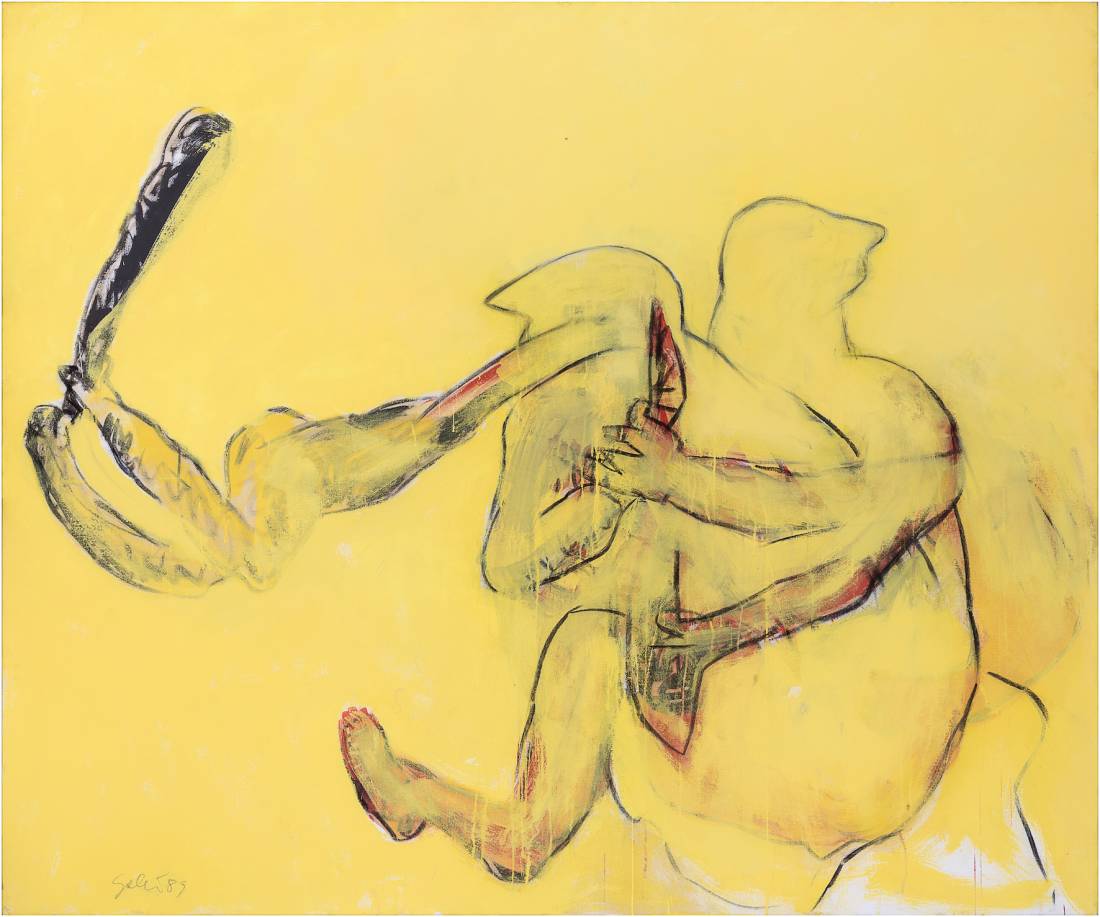Type:
Country:
Categories:

GALLI
So, So, So
21 Jun–08 Sep 2024
Opening Event: Thurs 20 Jun, 6-9PM
‘The body as a battlefield – that applies to everyone.’ Galli, 2015
So, So, So marks the first UK solo exhibition of artist Galli (b.1944, Germany). Spanning painting, books, collages, and drawings, the exhibition includes works from across her decades long practice. After initial commercial success in the 1980s, Galli’s work was little exhibited, but has rightly gained increasing attention in recent years, with work included in the Berlin Biennale (2020), brunand brunand (2021) gallery, and in Unruly Bodies, a group show at Goldsmiths CCA in 2023, amongst others. Galli’s work is a powerful current position on corporeality in a fractious and violent age that proposes an exhilarating, ribald, and haunting grammar of the body. The exhibition’s title – So, So, So – refers to the melodic cadence of the artist’s speech, and, in both English and German, gestures to openness, something to come, and excess.
Galli was born Anna-Gabriele Müller in Saarbrücken. Born at the end of the Second World War, her short stature went luckily unnoticed during her infancy under Nazi rule. She initially trained under painters of the Cobra movement, who emphasized an aesthetic break with Western ideals, naturalism, and abstraction. In 1969 she moved to West Berlin to further her studies under painter and graphic artist Martin Engelmann, whose work references Hieronymus Bosch, Pieter Bruegel and Surrealism. In the 1970s, West Berlin was a city at a turning point, moving away from the hangovers of Nazi fascism and post-war depression, to increasing freedoms, blossoming into an avant-garde scene of squatting, punk music, and feminist and queer civil rights movements. The body as a battlefield was central to these shifts, an arena Galli’s blistering work enters.
Galli’s work is freely expressive, instinctive, guttural, and gestural, but as an artist she is governed by strong discipline. Even today, despite severe health and mobility restrictions, she draws daily. The exhibition includes a wide array of drawings, selected to demonstrate the movement of figures and forms through different iterations. Galli draws rapidly, so each has a palpable immediacy, but their chain of evolution evidences a long-time span of deciphering and translation into new compositions that modulate figures, shapes and intensities.
Paintings have been selected from the 1980s to 2000s. Some are part of series that used a particular formal device, such as the paravent folding screen, or that were made during a specific period, such as her residency in Florence in 1990. Often made at a large scale, they are incredibly physical works, that bear the traces of their making; ‘It’s about chaos, sorting, chaos, sorting.’ Galli emphasizes her instinctive process, working on a figure and sometimes completely painting over it, until a character is developed that holds a desired emotional force and communicative energy. The resulting figures are anti-heroic, frequently genderless, abject, and often violently contorted and convulsed. They are rendered flesh through spare lines and vivid colour, provoking intense affect. Her approach to figures has often been read through the lens of her short stature and queerness, but Galli herself views this interpretation as limiting.
Works such as o.T (es lebe Der breite Prinsel) (1989) and Hocker (1989) directly reference the act of art making, as a violent process of fragmentation. Despite the intensely personal dialogue through which the works are created, they never impose a singular reading, or refer to the artist as the arbiter of meaning. Her works draw on sources such as mythology, art history, and the particularities of sexual desire, but through formal ambiguity flattens hierarchies of interpretation.
Latter pieces concentrate more closely on domestic space, so that figures grow out of washing machines, or objects speak to one another in claustrophobic boxed-in spaces. Here a sense of home becomes ambivalent, as a safe enclosure, but also an unbearable pressure chamber that swallows the body and erodes the division between object and subject.
Whilst her West Berlin contemporaries, the Neue Wilde, drew on the energies of punk, Galli occupied a different territory, mixing with literary figures such as Romanian poet Oskar Pastior, the only German-language member of the Oulipo and with whom she produced an artist book, and Swiss playwright and novelist Max Frisch whose work examines the tensions of identity and social conventions. Her works often incorporate texts, within the pictorial plane or as punning titles, in a Dadaist mode of quotation from newspapers, a shopping list, poem, or what might have been playing on the radio.
Artist:
Galli (b. 1944, lives in Berlin). From 1962 to 1967, Galli studied painting at the Saarland Art School in Saarbrücken. In 1969 she began further studies at the Hochschule der Künste in Berlin (today UDK). From 1992 to 2005, she taught at the FH Münster. Relevant exhibitions include CCA Goldsmiths, London (upcoming, solo, 2024); Museum Frieder Burda, Baden-Baden (2023); CCA Goldsmiths, London (2023); Kraupa-Tuskany Zeidler, Berlin (solo, 2022); Spaced Out, Gut Kerkow (solo, 2022); brunand brunand, Berlin (solo, 2021); 11th Berlin Biennale for Contemporary Art, KW, Berlin (2020); Haus am Lützowplatz, Berlin (solo, 2015); Saarländische Galerie im Palais am Festungsgraben, Berlin (solo, 2008); Kunstverein Augsburg (solo, 2005); Saarlandmuseum, Saarbrücken (2003); Museum St. Ingbert (solo, 2004); Musées de la Cour d’Or, Metz (2001); Stadtgalerie Saarbrücken (solo, 1992); Villa Romana, Florence (solo, 1990); Salzburger Kunstverein, Salzburg (solo, 1989); Städtisches Bodensee-Museum, Friedrichshafen (solo, 1985); Gropius Bau, Berlin (1983); Moderna Galerija Ljubljana (1983); Galerie der Berliner Festspiele, Berlin (solo, 1981); Max-Planck-Institut für Bildungsforschung, Berlin (solo, 1980); Modersohn-Becker-Haus, Bremen (solo, 1978).
St James's, London SE14 6AD
- 429 reads

